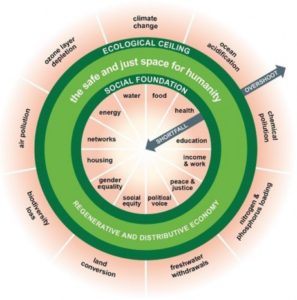Ecological Economics
Asad Zaman
This item continues a series of posts on the numerous changes required for creating a Macro-economics for the 21st Century. And I have also recorded a related lecture on Economics for the 21st century.
Eurocentric history portrays the West as advanced, rational, scientific and democratic, while the East is superstitious, unscientific, autocratic, and backwards. This poisonous philosophy was developed to justify the incredibly brutal and ruthless violence that was required for planetary conquest, and continues to sustain extremely exploitative economic systems. A partial antidote to the poison is World Systems theory which portrays all human beings, nations, and cultures, as joint participants in weaving the rich fabric of human history.

The subject of ecological economics goes further to take the entirety of humanity as one element of the biosphere and geosphere of our planet. All of the biological species have their “economics” where they consume and produce, directly or indirectly affecting other species. All of these economies are closely interlinked. Viewed in this light, the environment crisis is easily seen as being due to human beings’ predatory consumption of vast proportions of the biosphere and the geosphere, without compensatory productive replenishment.
Conventional economics assumes that ever-increasing GDP is desirable and possible, and that everyone benefits, because it does not take into account costs inflicted on the biosphere and geosphere, which will ultimately be borne by human beings as well. Ecological economics takes a much broader perspective and recognizes that there are more things contributing to human wellbeing than just the amount of stuff, such as health and education (human capital), friends / family (social capital) and the contribution of the earth and its biological and physical systems (natural capital). Its goal is to develop a deeper scientific understanding of the complex linkages between human and natural systems, and to use that understanding to develop effective policies leading to a world which is ecologically sustainable, has a fair distribution of resources (both between groups and the generations of human beings and between humans and other species) The related field of Green Economics is in general a more politically applied form of the subject.
Doughnut economics is a visual frame- work for sustainable development – shaped like a doughnut – combining the concept of planetary boundaries with the complementary concept of social boundaries. It was proposed to regard the performance of an economy by the extent to which the needs of people are met without overshooting Earth’s ecological ceiling. The name derives from
the shape of the diagram, i.e. a disc with a hole in the middle. The centre hole of the model depicts the proportion of people lacking access to life’s essentials (healthcare, education, equity and so on) while the crust represents the ecological ceilings (planetary boundaries) that life depends on and must not be overshot. Consequently, an economy is considered prosperous when all twelve social foundations are met with- out overshooting any of the nine ecological ceilings. This situation is represented by the area between two rings, namely humanity’s safe and just space The diagram was developed by economist Kate Raworth in Oxfam paper A Safe and Just Space for Humanity and elaborated upon in her book Doughnut Economics: Seven Ways to Think Like a 21st-Century Economist.
Source: WEA Pedagogy Blog, 26 Nov 2020 https://weapedagogy.wordpress.com/2020/11/26/ecological-economics/



























